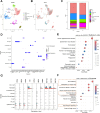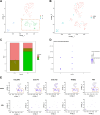FN1 from cancer-associated fibroblasts orchestrates pancreatic cancer metastasis via integrin-PI3K/AKT signaling
- PMID: 40678072
- PMCID: PMC12267018
- DOI: 10.3389/fonc.2025.1595523
FN1 from cancer-associated fibroblasts orchestrates pancreatic cancer metastasis via integrin-PI3K/AKT signaling
Abstract
Objective: The metastasis of pancreatic ductal adenocarcinoma (PDAC) is closely linked to the remodeling of cancer-associated fibroblasts (CAFs) within the tumor microenvironment (TME), though the precise molecular mechanisms remain unclear. This study aims to elucidate the role of CAFs in PDAC metastasis.
Methods: We integrated transcriptomic (GSE183795) and single-cell sequencing data (GSE156405) to screen for core genes associated with PDAC. In vitro co-culture models, functional assays (Transwell migration, Western blotting, qRT-PCR), and clinical data analysis were employed.
Results: Multi-omics analysis identified FN1 as a pivotal hub gene in the PI3K pathway, highly expressed in metastatic CAF subsets. In vitro experiments confirmed that FN1 activates the PI3K/AKT pathway through integrin receptors, influencing cell invasion and the immune microenvironment. Combined inhibition of the PI3K/AKT pathway and integrins synergistically suppressed tumor invasion. Clinical data showed that high FN1 expression correlated with shortened patient survival and an immunosuppressive microenvironment (M2 macrophage/Treg cell infiltration).
Conclusion: FN1 directly drives PDAC metastasis via the integrin-PI3K/AKT axis and indirectly promotes a "cold tumor" microenvironment by recruiting immunosuppressive cells. This dual role of FN1 enhances our understanding of CAFs heterogeneity and offers novel therapeutic strategies for PDAC.
Keywords: cancer-associated fibroblasts; fibronectin 1; integrin-PI3K/AKT signaling axis; metastasis; pancreatic cancer.
Copyright © 2025 Zhu, Li, Liu and Xiao.
Conflict of interest statement
The authors declare that the research was conducted in the absence of any commercial or financial relationships that could be construed as a potential conflict of interest.
Figures






Similar articles
-
PLAGL2 as a prognostic biomarker and an EMT-promoting factor in PDAC.Sci Rep. 2025 Jul 14;15(1):25425. doi: 10.1038/s41598-025-09591-x. Sci Rep. 2025. PMID: 40659704 Free PMC article.
-
M1 Macrophage-Derived TNF-α Promotes Pancreatic Cancer Ferroptosis Via p38 MAPK-ACSL4 Pathway.Curr Mol Med. 2025 Jul 10. doi: 10.2174/0115665240374551250630075409. Online ahead of print. Curr Mol Med. 2025. PMID: 40653839
-
TYROBP overexpression alters macrophage phenotype and enhances pancreatic cancer stemness through STAT3 and PKM2 signaling.Cell Signal. 2025 Oct;134:111949. doi: 10.1016/j.cellsig.2025.111949. Epub 2025 Jun 18. Cell Signal. 2025. PMID: 40553966
-
Vitamin D and Pancreatic Ductal Adenocarcinoma-A Review of a Complicated Relationship.Nutrients. 2024 Nov 27;16(23):4085. doi: 10.3390/nu16234085. Nutrients. 2024. PMID: 39683479 Free PMC article.
-
The type I collagen paradox in PDAC progression: microenvironmental protector turned tumor accomplice.J Transl Med. 2025 Jul 4;23(1):744. doi: 10.1186/s12967-025-06778-8. J Transl Med. 2025. PMID: 40616159 Free PMC article. Review.
References
LinkOut - more resources
Full Text Sources
Miscellaneous

